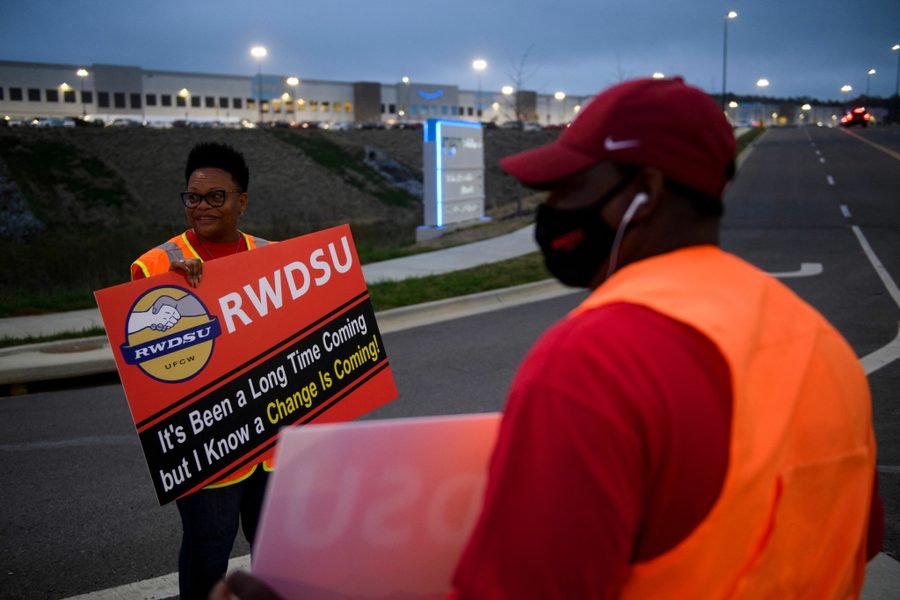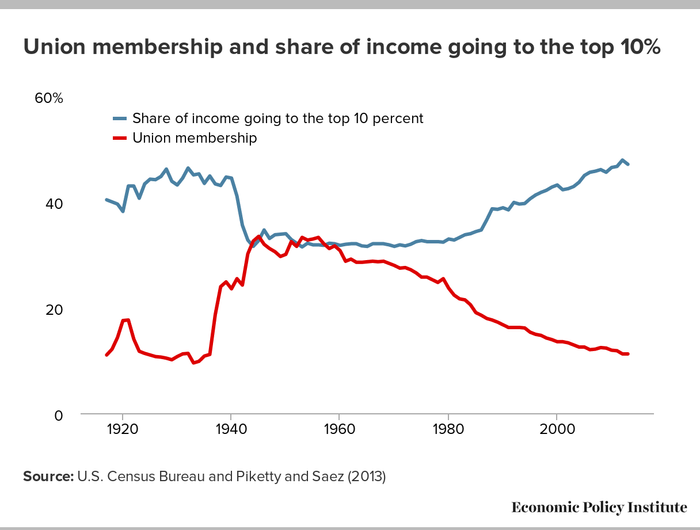Get the Federal Government to Fund Union Organizing. Now.
The most obvious and brilliant idea to revive organized labor, fast.
Hamilton Nolan

Though you wouldn’t know it from the actions of the federal government over the past half century, it is the stated policy of the federal government to “encourage collective bargaining.” It’s right there in the National Labor Relations Act (NLRA). Unions and their political supporters have typically taken this to mean that collective bargaining rights should be legally protected, and the fight to achieve that simple goal never ends. But as the popularity of unions relative to business hits an all time high, the time has come to interpret this directive more expansively. Because the reality is that there can be no collective bargaining without unions. Unions require organizing, and large scale organizing requires money. The money for this organizing can come from the federal government. We need to start demanding it.
Scarcely one in ten American workers are union members. That figure has been declining since it peaked shortly after World War II. It has fallen by half since the early 1980s, as the Reagan era burst into full gear and the four-decade-long explosion of economic inequality began. You may have seen the chart showing the share of income going to the top earners rising in perfect parallel with the decline of union density, the one chart that more than any other explains the state of America today. This inequality — the massive trend that underlies most of our country’s most serious problems — will not be reversed until organized labor is strong again. Union density must first stop going down, and then it must start going up. Way up, and fast.
Why is it so hard to make that happen? Well, part of it is the fact that labor law in America has been hammered into shape by business interests with the goal of weakening labor and making unions hard to build and maintain. The PRO Act, passed by the Democratic U.S. House, would go a long way towards changing those laws. But whether it becomes law or not, the case remains that unions will have to organize not tens or hundreds of thousands but millions of new members in order to move the needle on a national level. The limiting factor to accomplishing that is not public sentiment — polls show that tens of millions of workers would like to join a union if they could — but rather the raw ability of America’s unions to organize on such a large scale. Simply put, unions don’t have the resources to organize that many people. They don’t have enough organizers. And they don’t have enough money to hire and deploy those organizers. If they did have that money, and they deployed it wisely, there is no doubt that union density would finally turn around.

Take, for example, the Amazon warehouse union drive in Alabama that has so captivated the world. The union, the Retail, Wholesale and Department Store Union (RWDSU), has flooded that warehouse with organizers, and other unions have thrown in organizers as well. All this, to try to unionize around 6,000 workers. Amazon has 1.3 million workers, and hundreds of warehouses across the country. The RWDSU says it has received a thousand inquiries from other Amazon workers interested in organizing. Do they have the organizing resources to run, say, ten or twenty or fifty more warehouse campaigns like the one in Alabama simultaneously? No, they do not. Not because they don’t know how, but because there are simply not enough organizers to do it, and there is not enough money in union budgets to hire the vast army of organizers necessary to do the job. Not even at Amazon — a single company.
Unions are funded by member dues, but those dues do not start coming in until a first contract has been signed. That means that organizing new unions requires a large up-front investment of resources that is gradually paid back over time. Not even the biggest unions can front the money to organize a million new workers, despite the fact that the money would eventually come back in the form of dues. But you know who could give us that money without breaking a sweat? The federal government. No problem. A billion dollars to hire the organizers to unionize a million new workers is out of the reach of any union, but it is just a rounding error to Uncle Sam.
This is not welfare. This is an investment in the ability of workers to collectively bargain, which, as you recall, is a priority of the government. It is also an excellent investment in the promotion of social and economic equality — handing money to the working poor is only a momentary solution, but helping those working people get a union gives them a tool that will allow them to gain money and power for decades to come. I do not want the federal government to pay all the operating expenses of a union, or to pay the six-figure salaries of union presidents. I want the federal government to provide the money necessary to organize new union members on a scale that will benefit everyone. A simple, direct investment with well-understood tangible benefits. Most good union organizers make modest salaries, work extremely hard, and achieve surprisingly powerful results. A billion dollars a year could revolutionize the balance of power between labor and capital in America. I challenge you to find a better deal anywhere.
When you consider the fact that every industry in America has a well-funded lobbying program designed to extract money from the federal government, it is shocking that unions have not done this already. (Christian Sweeney, the deputy organizing director of the AFL-CIO, said he knows of no such efforts to get government organizing money.) Unions, of course, do all sorts of business with the federal government, and lobby for all sorts of laws and perks for their members. Airline unions just won tens of billions of dollars to cover member salaries during the pandemic, and unions just won an $86 billion rescue of their failing pension plans in the latest relief bill. Unions can get money from the government. They just do not focus in an honest way on the question of how to achieve large-scale organizing. But they could.
While researching this, I learned that I am not the first person to come up with this brilliant (and obvious) idea. Will Bloom, a labor lawyer in Chicago, wrote an essay in 2017 calling for the government to subsidize labor organizing. His suggestion was that a grantmaking board be established under the NLRB or another agency which would fund organizing projects. One can also imagine funding with strict guidelines going directly to major unions, or even to a central organizing body created by the AFL-CIO to fund major organizing campaigns. In any case, the specific disbursement structure is less important than the fact that money is flowing from the government into labor organizing.
Bloom told me he sees no legal reason why this funding could not exist — if it came in the form of government grants, it would just be reported by the union on its disclosure forms like any other grant. I also asked the labor lawyer Brandon Magner about this idea, who told me “I am unaware of any obvious legal obstacles that would bar such subsidizing or invoke a strong court challenge.” In other words, the barrier to getting this money does not seem to be a legal one, but rather a political one.
At our present political moment, the failure of political will and imagination here actually rests on the shoulders of organized labor itself. Joe Biden has shown himself to be the most pro-union president in decades. The Democratic Congress and the Biden administration have shown themselves to be willing and able to appropriate trillions of dollars in social spending to promote the same sorts of goals that an increase in union density would achieve. On top of that, Congressional earmarks — pet funding programs that each Congressperson can request be added to bills — are coming back, meaning that labor-friendly members of Congress could be pressed to fund labor organizing projects in their own districts. It is no exaggeration to say that there has never been a more opportune time to get this money. It is equally obvious that this opportune moment will pass.
A billion dollars is nothing to the government. But America would be staggered to see what 10,000 new union organizers could do with it. Please: get this money, before it’s too late.
Hamilton Nolan is a labor writer for In These Times. He has spent the past decade writing about labor and politics for Gawker, Splinter, The Guardian, and elsewhere. More of his work is on Substack.








